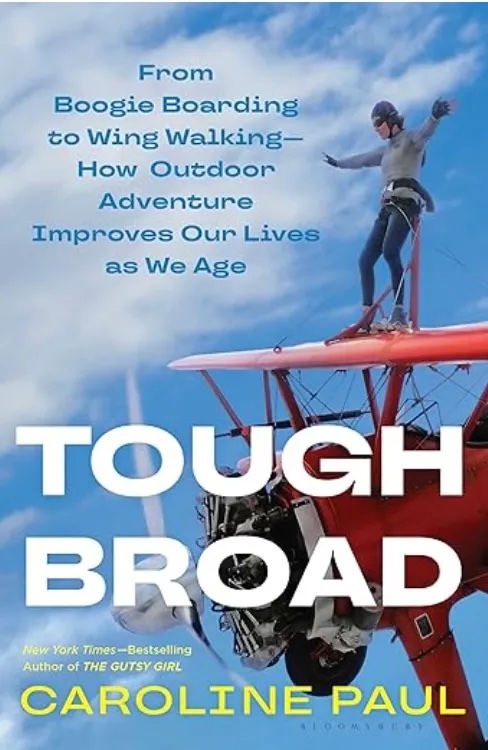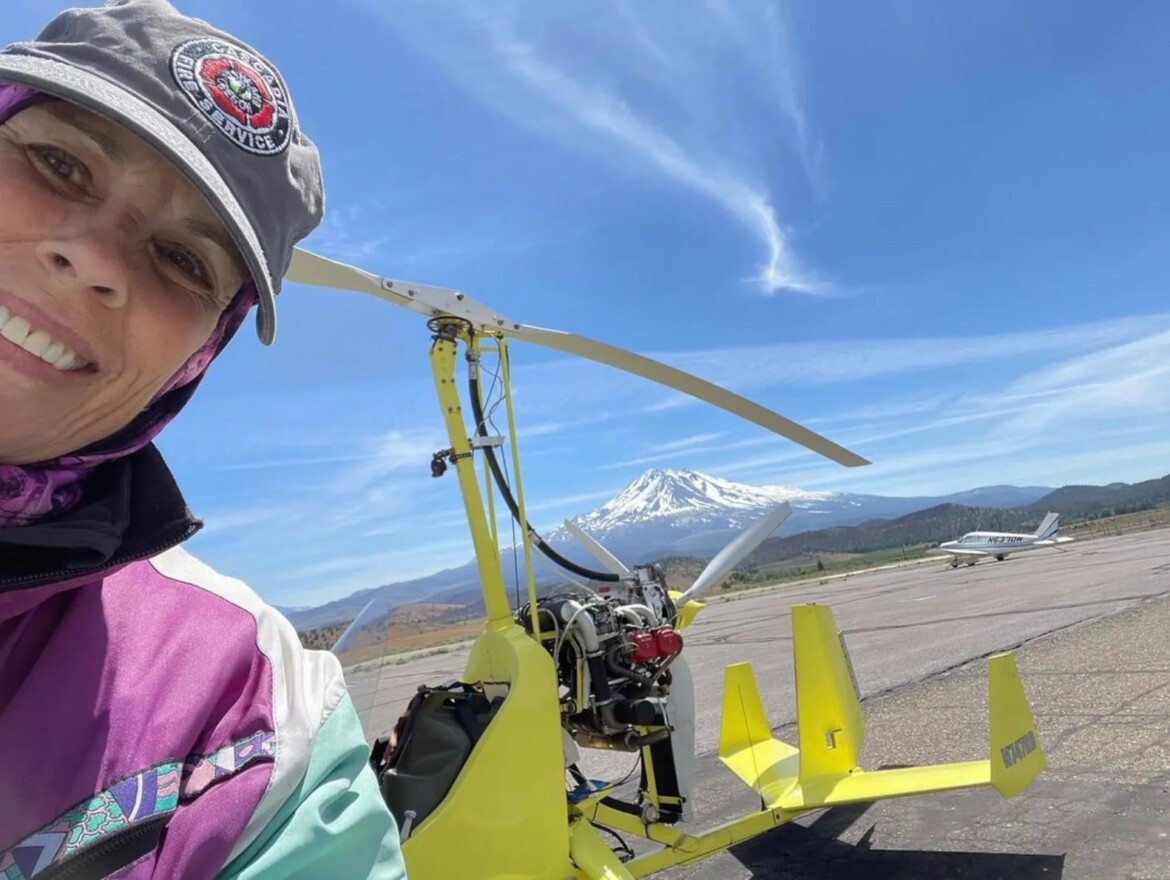Caroline Paul has been an adventurer for much of her life.
She was a whitewater guide in her teens, got her pilot’s license at 20, and at 25, became one of San Francisco’s first female firefighters—a position that entailed physical bravery and risk. She’s gone mountain biking in the Bolivian Andes and camped in a blizzard on Denali, the highest mountain peak in North America.
Now 60, a favorite activity—given a free day and good weather—is to drive from her San Francisco home to the Petaluma airport to board her gyrocopter, a wisp of a machine that flies like a helicopter but uses air, not a motor, to turn the blades.

Videos that Paul has posted on Instagram might make most people’s stomach drop. They show a smiling Paul in an open-air yellow gyrocopter flying high over hills, vineyards, rivers and the ocean. The gyrocopter vibrates in the wind, lurching side to side, but Paul exudes pure happiness. “I am giddily in love with flying gyrocopters,” she has declared.
That sheer joy of adventuring is at the center of Paul’s new book, “Tough Broad: From Boogie Boarding to Wing Walking—How Outdoor Adventure Improves Our Lives as We Age” (Bloomsbury Publishing, 288 pages, $27.99), which came out March 5. In addition to exploring her own adventures, including learning to navigate the gyrocopter and wing walking on a biplane (featured on the book’s cover), Paul also profiles older women who embrace outdoor challenges and are more resilient and happier as a result.
There’s Shawn Brokemond, a 54-year-old BASE jumper who catapults herself off El Capitan in Yosemite National Park; Kittie Weston-Knauer, a 74-year-old BMX racer who is the oldest female racer competing in the U.S.; 71-year-old Cynthia Hicks, who walks on the wings of planes, and 80-year- old scuba diver Louise Wholey, among others.
In “Tough Broad,” Paul argues that society tells aging women to retreat and wither away. But the secret to a good life is spending time in nature, trying something novel, and challenging oneself physically. Outdoor adventure can profoundly change older women’s bodies and minds, she writes.
“The messaging for women as we age is just so toxic, it’s so negative,” said Paul in a recent interview.
“The message is that our brains are in decline, our bones are in decline. We’re no longer relevant, we’re boring. We’re invisible. There’s not a lot of representation of these super fun, kind of reckless badass women.”
Paul was not always adventurous. She grew up in New York and rural Connecticut and was a shy kid, unlike her twin Alexandra, who was outgoing. Paul’s parents did not take the twins and their younger brother Jonathan hiking or camping, but let them roam the countryside until dark.
Paul biked and swam like most kids. It was as a young adult, after absorbing stacks of National Geographic magazines that displayed the beauty of nature, that her idea of outdoor adventure expanded.
“Once I became an adult, my idea was I wanted to get paid to have adventures,” she said.
And she had them. She trained as a whitewater guide. She led trips on the American River and eventually teamed up with other female guides to try first ascents of rivers around the world. She studied journalism at Stanford University with the idea of becoming a documentary filmmaker.
She worked at the San Francisco Fire Department for 13 years, and left to write a memoir, “Fighting Fire.” A member of the San Francisco Writer’s Grotto, Paul also published the New York Times bestseller, “Gutsy Girls: Escapades for Your Life of Epic Adventure” and “Lost Cat: A True Story of Love, Desperation and GPS Technology.”

As she got older, Paul noticed there were few women her own age out surfing, paragliding or boogie boarding. That observation motivated her to write “Tough Broad.”
“When I was 55 and looking around and seeing that there were no women doing the kind of things I was doing, I had to ask myself, ‘Is this right? Maybe I should be pulling back,’” said Paul. “And I had a feeling that that wasn’t true. I went on a quest to find that answer for myself.”
The pandemic stopped Paul’s plans to travel and find older, adventurous women. But it gave her the time to dig into medical literature about aging. She grew particularly interested in “the psychology of the way we approach aging, the messages we’re told, the messages we believe.” She explored how spending time outdoors is an antidote to loneliness and can help process grief.
When Paul was finally able to travel, she accompanied the women she profiles on their adventures. She served as a support person when Brokemond hurled herself in the air in Yosemite. She went scuba diving with the 80-year-old Wholey. She boogie boarded with a group of 70-year-olds known as the Wave Chasers in San Diego.
Not every woman wants to scuba dive, so Paul knew she needed to find women who went birdwatching or hiked, activities more accessible to an aging body. Spending time with women doing so-called easier sports was also revelatory. Paul discovered that “adventure doesn’t mean high adrenaline!” Birdwatching or walking through a park can be as exciting and restorative as more high-octane activities if a woman slows down and pays close attention. Paul discovered awe, the act of appreciating a leaf or a cloud. Just spending time offers all the benefits of adventuring.
“We had been awash in nature, which is such a potent elixir,” Paul wrote about a walk she took with 93-year-old Dot Fisher-Smith. “And Dot’s ability to be delighted by little things—the soil, the grass, the trees, our conversation—added an exhilaration I hadn’t expected. Exhilaration, I was beginning to see, doesn’t need adrenaline. It can be triggered by that simple act of paying attention.”
In another chapter, Paul watches as 59-year-old Diane Espaldon learns to swim. It is not the type of adventure that usually gets written up, but Paul is there to observe what happens when an older woman learns something new. Diane has tried to learn to swim at least five times before, but without success.
“Invigorating the brain with novelty is one of the best ways to keep it sharp,” wrote Paul. “It is also a way to fend off other attributes that afflict us as the years progress—depression, for one. Low self-esteem, for another.
“Perhaps most important, goal setting of this sort is vital to our continued sense of purpose, which often sags as we age.”
Paul concluded in “Tough Broad” that there are five pillars for fulfilling aging: having a community, novelty, having a purpose, health and having a positive mindset about aging itself. She hopes her book will be a clarion call for women to embrace adventure, not shrink from it, as they grow older.
“I want [women] to understand that the way we look at our aging is the single most significant factor in how well we age, Paul said in press materials for the book. “I believe that getting outside and finding exhilaration, exploration, physical vitality, and a host of other emotions fly in the face of all the negative messaging we get about what we can and cannot do as we get older.
Caroline Paul speaks about “Tough Broad” at 7 p.m. March 5 at Mrs. Dalloway’s Books, 2904 College Ave., Berkeley and at 5:30 p.m. March 20 at the Commonwealth Club, 110 The Embarcadero, San Francisco.
The post In ‘Tough Broad,’ Caroline Paul tells stories of ‘super fun, badass women’ appeared first on Local News Matters.
